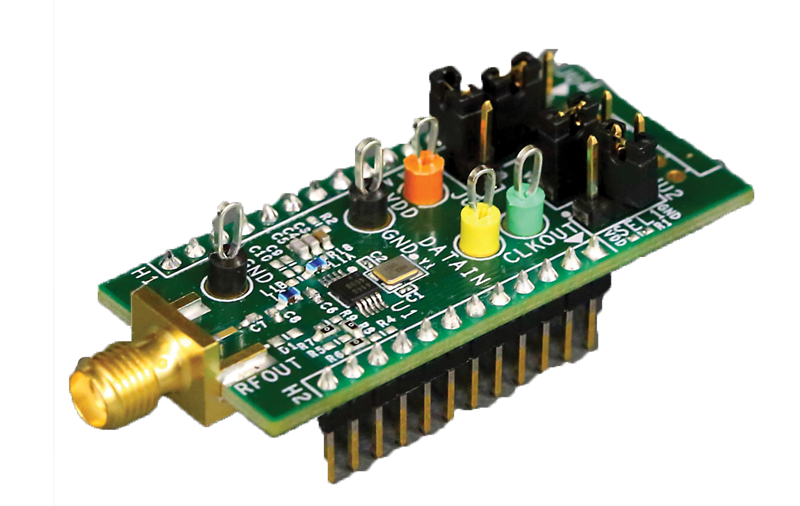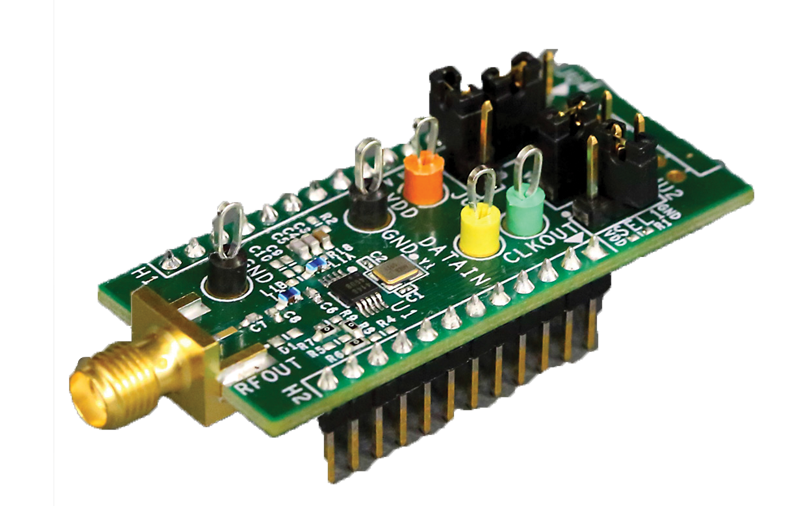MAX41461
MAX41461
PRODUCTION300MHz–960MHz ASK Transmitter with I2C Interface
High Output Power for Long Range, with Low Current Consumption - Fully Programmable at a Low Implementation Cost
- Part Models
- 2
- 1ku List Price
- Starting From $0.85
Viewing:
Part Details
- Low Implementation Cost
- Bits-to-RF Single Wire Operation
- Low Bill-of-Materials (BOM)
- Uses Single, Low-Cost, 16MHz Crystal
- Small 3mm x 3mm μMAX-10 Package
- Increased Range, Data Rates, and Security
- Up to +16dBm PA Output Power
- Fast Frequency Switching for FHSS/DSSS
- Fast-On Oscillator: < 250μs Startup Time
- Up to 200kbps NRZ Data Rate
- Extend Battery Life with Low Supply Current
- < 8mA ASK Manchester Coded
- Selectable Standby and Shutdown Modes
- Auto Shutdown at < 20nA (typ) Current
- Ease of Use
- Pin Selectable 300MHz–928MHz Frequencies
- Pin Compatible ASK and FSK Versions
- +1.8V to +3.6V Single-Supply Operation
- Fully Programmable with 400kHz/1MHz I2C Interface
The MAX41461/MAX41462 is a UHF sub-GHz ISM/SRD transmitter is designed to transmit On-Off Keying (OOK) or Amplitude-Shift Keying (ASK) data in the 286MHz to 960MHz frequency range. It integrates a fractional phase-locked-loop (PLL), so a single, low-cost crystal can be used to generate commonly used world-wide sub-GHz frequencies. The fast response time of the PLL allows for frequency-hopping spread spectrum protocols for increased range and security. The chip also features preset modes with pin-selectable frequencies so that only one wire is required for external microcontroller interface. The only frequency-dependent components required are for the external antenna matching network. Optionally, the device can be put into programmable mode and programmed using an I2C interface. The crystal-based architecture of the MAX41461/MAX41462 eliminates many of the common problems with SAW-based transmitters by providing greater modulation depth, faster frequency settling, higher tolerance of the transmit frequency, and reduced temperature dependence. A clock-out signal at 800kHz is also provided.
The MAX41461/MAX41462 provides output power up to +13dBm into a 50Ω load while drawing < 8mA (Manchester coded). The output load can be adjusted to increase power up to +16dBm, and a PA boost mode can be enabled at frequencies above 850MHz to compensate for losses. The PA output power can also be controlled using programmable register settings in I2C mode.
The MAX41461/MAX41462 also features single-supply operation from +1.8V to +3.6V. The device has an auto-shutdown feature to extend battery life and a fast oscillator wake-up with data activity detection.
The MAX41461/MAX41462 is available in a 10-pin μMAX package and is specified over the -40°C to +105°C extended temperature range. The MAX41461/MAX41462 has an ESD rating of 2.5kV HBM.
![]() Design Solution: How to Maximize the Wireless Power Range of Your UHF Sub-GHz Short-Range Device ›
Design Solution: How to Maximize the Wireless Power Range of Your UHF Sub-GHz Short-Range Device ›
Applications
- Automatic Meter Reading (AMR)
- Building Automation and Security
- Garage Door Openers (GDO)
- Internet of Things (IoT)
- Radio Control Toys
- Remote and Passive Keyless Entry (RKE/PKE)
- Tire Pressure Monitoring Systems (TPMS)
- Wireless Sensors and Alarms
Documentation
Data Sheet 1
Technical Articles 1
Video 1
ADI has always placed the highest emphasis on delivering products that meet the maximum levels of quality and reliability. We achieve this by incorporating quality and reliability checks in every scope of product and process design, and in the manufacturing process as well. "Zero defects" for shipped products is always our goal. View our quality and reliability program and certifications for more information.
| Part Model | Pin/Package Drawing | Documentation | CAD Symbols, Footprints, and 3D Models |
|---|---|---|---|
| MAX41461GUB+ | 10-MINI_SO-N/A | ||
| MAX41461GUB+T | 10-MINI_SO-N/A |
This is the most up-to-date revision of the Data Sheet.
Software Resources
Can't find the software or driver you need?
Request a Driver/SoftwareTools & Simulations
Software Development 2
IBIS Model 1
Evaluation Kits
Latest Discussions
No discussions on MAX41461 yet. Have something to say?
Start a Discussion on EngineerZone®




